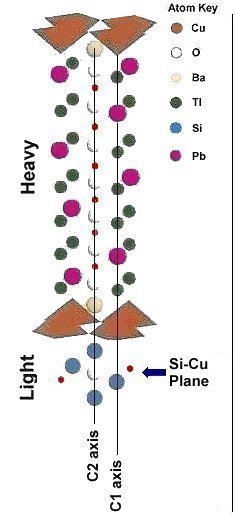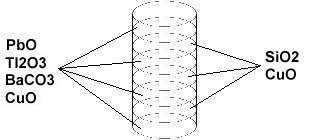

Silicon Substitution Advances High Tc Above 35 C
"Remarkable!"- Dr. John Clem, Senior Physicist Emeritus,
Ames Laboratory, Iowa State University


Superconductors.ORG herein reports the 30C superconductor discovered in December 2012 has been successfully reformulated to advance high Tc above 35 Celsius (95F, 308K). This was accomplished with a simple substitution of tetravalent silicon into the magnesium atomic sites. The chemical formula thus becomes Tl5Pb2Ba2Si2.5Cu8.5O17+. This is the third material discovered with a critical transition temperature (Tc) above room temperature.
Multiple magnetization tests were performed on two separate test pellets to confirm this exceptionally high Tc. The highest and lowest measurements on the first sample ranged from 37.1 C to 35.8 C. The second pellet produced diamagnetic transitions between 37.5 C and 35.5 C. The average of all the tests was just under 36 Celsius. The flashing lines in the two plots at page top represent the average of the noise component skewing apart near 36 C in both warming and cooling test cycles.1

|
With an ionic radius smaller than magnesium (0.4 Å - vs - 0.72 Å) silicon will occupy the same atomic sites in the "Light" region of the C1 and C2 axes as magnesium does. This is illustrated in the D223 graphic at left with an arrow pointing to the Si-Cu plane. Though the planar weight ratio is lower with silicon than with magnesium, the Cu02 planes clearly benefit from being electron-doped.
Below is the plot of a second sample pellet,
synthesized and tested three days after the first pellet. The plot again shows an unambiguous diamagnetic
transition just below 36 C. Resistance tests were not possible with this formulation, as the
non-superconductive bulk material is an insulator at room-temperature. A measureable bulk resistance
is required to observe a resistance change resulting from a minority phase.

|
The idea that silicon might be an acceptable substitute for magnesium came from two prior discoveries that included silicon. The proto-compound TlSiBa4Tm2CaCu5Ox produced a minority phase with Tc near 208 Kelvin. And (Tl0.5Pb0.5Si)Sr4TmCaCu4Ox produced a minority phase with Tc near 213 K. The only way for such high transition temperatures to result from such small unit cells was if silicon were occupying both the C1 and C2 axes.
A dot and yellow rectangular box have been placed within the C1 plot below, depicting where D223(Si2.5Cu8.5) lies relative to the other high performance thallium copper-oxides. Even though the planar weight ratio has decreased along the C1 axis, with this formulation the rich electron doping of the CuO2 planes has increased Tc well above the curve of its progenitors.

Anecdotally the test pellet was considerably harder than any of the prior magnesium or calcium formulations. Tl5Pb2Ba2Si2.5Cu8.5O17+ was prepared using the layer cake method, as shown below. Pellets one and two had 104 and 114 interference layers respectively. And, even using this technique, the volume fraction is low, requiring very sensitive test equipment.

The below stoichiometric ratios were used for the ODD layers:
Tl2O3 99.99% (Alfa Aesar) 7.366 grains...and the below ratios for the EVEN layers.
SiO2 99.996% (GE 214) 3.876 grains (4x stoichiometric)The chemical precursors were pelletized at 70,000 PSI and sintered for 35 hours at 865C. The pellet was then annealed for 10+ hours at 500C in flowing O2. Temperature was determined using an Omega type "T" thermocouple and precision OP77 DC amplifier. The magnetometer employed twin Honeywell SS94A1F Hall-effect sensors with a tandem sensitivity of 50 mv/Gauss.
RESEARCH NOTE: The copper-oxides are strongly hygroscopic. All tests should be performed immediately after annealing.
RE-PUBLICATION NOTICE: Elsevier Publishing, dba Elsevier Science, as well as Morris Communications, both print and broadcast divisions, are specifically prohibited from re-publishing any part of this news story.
E. Joe Eck
© 2013 Superconductors.ORG
All rights reserved.
1. Testing temperatures are believed accurate within +/- 0.40 degrees C.
 BACK to "News" page at Superconductors.ORG
BACK to "News" page at Superconductors.ORG